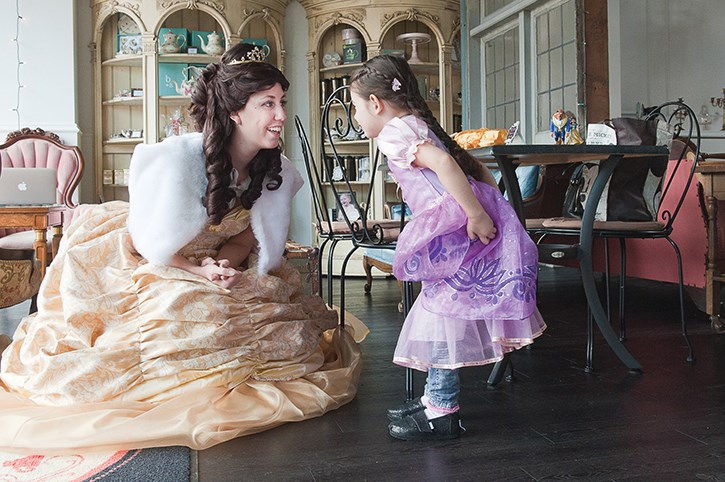My three-year-old daughter wanted a Rapunzel doll for Christmas. She first told me about this desire in mid-November when we sat down to write her letter to Santa.
“Why do you like Rapunzel?” I asked, not that her gift request came as any big surprise; at the time, she was watching Tangled three times a week.
“Rapunzel is funny and brave and magic,” she replied as she drew elaborate flourishes in crayon all over the envelope.
It wasn’t until a couple of weeks before Christmas that I found out that I could do one better than a Rapunzel doll simply by picking up the phone and calling in a professional.
Fast-forward to Christmas Eve. As the dinner dishes soaked and my husband arranged Santa cookies on a plate, my mother and daughter sat chatting about elves, reindeer and gift wishes (which, for my daughter, was still the Rapunzel doll).
“Wouldn’t it be wonderful if you could actually meet Rapunzel?” my mother asked as I idled near the front door.
“I would love it,” my daughter replied.
My mother grinned. “Then let’s close our eyes and imagine that Rapunzel is knocking at the door.”
My daughter closed her eyes, and suddenly we heard a knock at the door.
I opened the door to reveal Rapunzel, who with her purple gown and long golden braid looked almost exactly as she did in the film. My daughter stood frozen in place, eyes wide and dancing. Rapunzel knelt in front of her, offered her a candy cane, and greeted her by name.
For the next 20 minutes, they sat side by side in front of the Christmas tree. Rapunzel related a tale from her well-documented life as my daughter, now unfrozen, peppered her with questions. Next, they sang a song from Tangled, and then White Christmas, for which the grown-ups (who had been watching from across the room) joined in.
And then photos were taken, hugs were given and received, and Rapunzel was out the door.
“I am happy!” my daughter cried as she twirled around the room. “I am magic! I am princess!”
Christmas morning came, and the Rapunzel doll was a big hit, but nothing before or since has been as magical as those 20 minutes with the actual princess.
***
The young woman who knocked on my door that evening was 23-year-old Chelsea Scantland, the convivial force behind Bippity Boppity Birthdays. Her company has been dispatching princesses to events all over the Lower Mainland since 2011.
To date, Bippity Boppity princesses have appeared at more than 300 parties. Although she’s got a handful of other singing princesses on standby for busy weekends, it’s Scantland in full princess garb at the bulk of them.
“I’m four years old at heart,” she said in a recent phone interview. “Wearing these dresses and doing these parties, I’m happy all of the time.”
The princesses in the Bippity Boppity roster resemble the ones in the Disney films — although for legal reasons, they’re referred to by their fairytale names: Cinderella; Rapunzel; the Little Mermaid; Belle; the Highland Princess; the Arabian Princess; Snow White; the Snow Queen. Scantland sews and maintains the intricate costumes herself; the wigs are custom made (the Rapunzel wig alone cost $800).
If there’s one thing Scantland admires about all of the princesses in her roster, it’s their nuances. “I think each of the princesses has a flaw as well as strengths,” she said. “You can’t expect every princess to be perfect, or else it wouldn’t be an interesting journey.”
Sometimes Scantland will encounter mothers who disapprove of some aspect of princess life. “Some moms, when they hear that I’ll be teaching curtsying or manners, or that the girls might be getting their nails done, they’ll pull their girl aside and say, ‘No, we can’t get that today.’”
And so Scantland will tell young partygoers who compliment her make-up that it’s only for a special occasion, and that Cinderella loves soccer and baseball, just like they do — “to show that a princess can be more than just dancing.”
***
Princess culture is big business. If you’re so inclined, your daughter can be adorned in princess garments from head to toe while she plays with her princess toys, eats her princess snacks and dreams her princess dreams.
I’m so inclined. My daughter plays with princess dolls, watches princess movies, and (sometimes) plays with princesses (see above). And I call myself a feminist.
It makes it easier that the Mouse House — the primary pusher of Princess Culture — is resetting the tone of its princess movies. In movies like Brave, Tangled, The Princess & the Frog, and Frozen, the focus isn’t scoring True Love’s Kiss. It’s about Living Fearlessly. Being Independent. Working Hard. Accepting Yourself.
That said, I’ve let my daughter watch Cinderella and Snow White and the Seven Dwarfs, and I get guff — almost entirely from other mothers — for exposing my daughter to princess culture.
But I think the example I set, the totality of the experiences of her childhood, and our conversations have more of an impact than any movie. If we see something in a princess movie that doesn’t ring true for our family, we talk about it (and this is true for anything with which we come in contact, not just princesses). We’ve talked about how it’s better to take control of your destiny than be rescued, and how you should get to know someone really well before you marry them.
But mostly when we talk about the princesses we love, we talk about magical hair and talking animals, because why not? My daughter is three years old and she believes in magic. I wouldn’t have it any other way.



